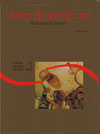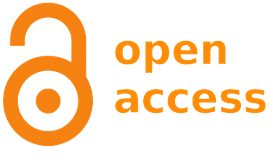<b>Morphological characterization of the trichomes on the leaves and stem of two Lamiaceae species known popularly as “false-boldus”</b> - DOI: 10.4025/actascibiolsci.v29i2.445
Abstract
The morphoanatomical description of vegetable species, for medical purpose, is necessary to foreground the analyses of quality control in the pharmacognostic laboratories. The objective of this study was to analyze two Lamiaceae species known as “false-boldus” (Plectranthus barbatus and P. grandis), characterizing and quantifying the trichomes present in their leaves and stems. For the morphoanatomical analyses transverse sections of the leaves, petiole, and stem were prepared, using common techniques of plant morphology and anatomy for the preparation of semi-permanent slides, stained with astra blue and safranin. Analyses revealed that the leaves of both species are morphologically similar, but differ with regard to dimensions. The glandular trichomes found were: peltate, short-capitate and long-capitate; and tectors (simple uniseriate with two or more cells in the base). With few exceptions, all five trichomes types were observed in the leaves, petiole and stem, and the averages obtained for P. grandis significantly were superior to the ones found in the P. barbatus organs, except for the trichome simple tector which was more abundant in the stem of the second specie.Downloads
Download data is not yet available.
Published
2007-12-05
How to Cite
Milaneze-Gutierre, M. A., Famelli, M. C., Capel, L. S., & Romagnolo, M. B. (2007). <b>Morphological characterization of the trichomes on the leaves and stem of two Lamiaceae species known popularly as “false-boldus”</b> - DOI: 10.4025/actascibiolsci.v29i2.445. Acta Scientiarum. Biological Sciences, 29(2), 125-130. https://doi.org/10.4025/actascibiolsci.v29i2.445
Issue
Section
Botany
DECLARATION OF ORIGINALITY AND COPYRIGHTS
I Declare that current article is original and has not been submitted for publication, in part or in whole, to any other national or international journal.
The copyrights belong exclusively to the authors. Published content is licensed under Creative Commons Attribution 4.0 (CC BY 4.0) guidelines, which allows sharing (copy and distribution of the material in any medium or format) and adaptation (remix, transform, and build upon the material) for any purpose, even commercially, under the terms of attribution.
Read this link for further information on how to use CC BY 4.0 properly.
0.6
2019CiteScore
31st percentile
Powered by 

0.6
2019CiteScore
31st percentile
Powered by 











1.png)




3.png)













